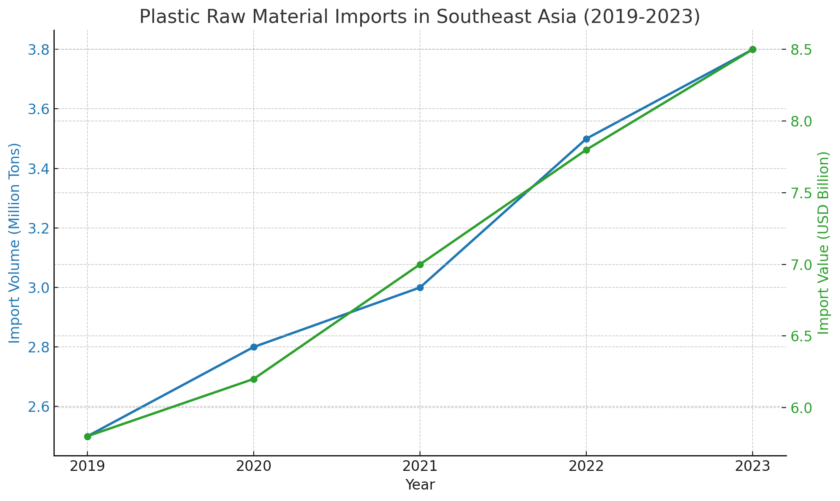Plastic Industry Value Chain in Southeast Asia with Import Analysis
Overview of the Plastic Industry Value Chain in Southeast Asia
The plastic industry value chain in Southeast Asia encompasses a series of processes from raw material production to end-product manufacturing and recycling. Each segment of the chain involves various stakeholders, technologies, and economic activities. The region’s dynamic market, driven by rapid industrialization and urbanization, makes it a critical hub for the global plastics industry.
1. Raw Material Production
Key Components
- Petrochemicals: The primary raw materials for plastic production, such as ethylene, propylene, and other monomers, are derived from petrochemicals.
- Natural Resources: Crude oil and natural gas are the main sources for these petrochemicals.
Major Producers
- Singapore: A leading producer with advanced petrochemical facilities.
- Thailand and Malaysia: Significant producers with large petrochemical complexes.->Malaysia Plastic Industry Research Report 2024-2033
2. Polymerization
Process
- Polymerization: The process where monomers like ethylene and propylene are converted into polymers such as polyethylene (PE) and polypropylene (PP).
- Key Products: Polyethylene (PE), Polypropylene (PP), Polyvinyl Chloride (PVC), Polystyrene (PS), and others.
- Vietnam reports with data and analysis:
- Vietnam Polyethylene Import Research Report 2024-2033
- Vietnam Polyvinyl Chloride(PVC) Resin Import Research Report 2024-2033
- Vietnam Polyethylene Terephthalate(PET) Resin Import Research Report 2024-2033
- Vietnam ABS resin Import Research Report 2024-2033
- Vietnam Polycarbonate Import Research Report 2024-2033
- Vietnam reports with data and analysis:
Contact Us for other data customized report.
Regional Players
- Thailand: Home to major polymer producers such as PTT Global Chemical.
- Malaysia and Indonesia: Growing presence in polymer production.->Indonesia Plastic Industry Research Report 2024-2033
3. Plastic Conversion
Techniques
- Injection Molding: Commonly used for producing items like containers and automotive parts.
- Extrusion: Used for manufacturing films, sheets, and pipes.
- Blow Molding: Applied in creating bottles and hollow containers.
Notable Manufacturers
- Vietnam: Emerging as a hub for plastic conversion due to its lower labor costs.
- Indonesia and the Philippines: Expanding capabilities in plastic product manufacturing.
4. End-Product Manufacturing
Applications
- Packaging: The largest segment, driven by food and beverage, consumer goods, and pharmaceuticals.->Research Report on Southeast Asia Plastic Packaging Industry 2023-2032
- Automotive: Utilization in parts and components due to plastics’ lightweight properties.->Research Report on Automobile Industry in Southeast Asia, 2022-2031
- Electronics: Use in casings, components, and insulation materials.
Key Markets
- Vietnam and Thailand: Major exporters of plastic products.->Vietnam Plastic Industry Research Report 2024-2033
- Indonesia and the Philippines: Increasing domestic consumption and export activities.
5. Distribution and Logistics
Channels
- Direct Sales: Manufacturers often sell directly to large clients.
- Distributors: Play a crucial role in reaching smaller manufacturers and end-users.
Infrastructure
- Port Facilities: Efficient ports in Singapore, Malaysia, and Thailand facilitate regional and global distribution.
- Logistics Networks: Well-developed road and rail networks support inland distribution.
6. Recycling and Waste Management
Practices
- Mechanical Recycling: The most common method, involving the reprocessing of plastic waste into new products.
- Chemical Recycling: Emerging technologies aimed at breaking down plastics into their chemical components.
Challenges
- Waste Management Systems: Varying levels of efficiency across the region.
- Environmental Regulations: Increasingly stringent regulations driving the adoption of sustainable practices.
Leading Initiatives
- Thailand and Malaysia: Implementing policies to boost recycling rates.
- Vietnam: Investing in recycling infrastructure to reduce environmental impact.->Vietnam Plastic Industry Research Report 2024-2033
The plastic industry value chain in Southeast Asia is characterized by robust growth and significant economic activities across all segments. The region’s strategic location, coupled with its natural resources and skilled labor force, positions it as a vital player in the global plastics market. However, challenges such as waste management and environmental sustainability need to be addressed to ensure long-term growth and sustainability.
Impact of Imported Raw Materials on the Plastic Industry Value Chain in Southeast Asia
Imported raw materials play a crucial role in the plastic industry value chain in Southeast Asia, influencing cost structures, operational efficiencies, and market dynamics. While they provide access to high-quality inputs necessary for production, they also introduce vulnerabilities related to supply chain stability and economic fluctuations. Strategic management of these dependencies, coupled with investments in local production and recycling capabilities, can enhance the resilience and competitiveness of the plastic industry in the region.
For the recent five years, the import of plastic raw materials in Southeast Asia shows a significant upward trend, driven by increased demand in countries like Vietnam, Malaysia, Thailand, and Indonesia. These countries have sustained economic growth, promoting the market demand for plastics and their products.

The data presented in the chart is sample data created for illustration purposes and does not reflect actual historical import statistics for plastic raw materials in Southeast Asia. Therefore, the reliability of this data is purely fictional and should not be used for real-world analysis or decision-making.
If you want to obtain reliable and accurate data, we will help you get actual data with our unique methods from reliable sources like:
- Government Trade and Industry Departments
- Our Market Research Reports
- Customs and Import-Export Databases
- Others
Feel free to contact us.

